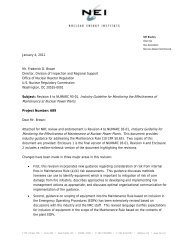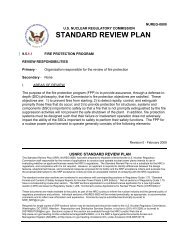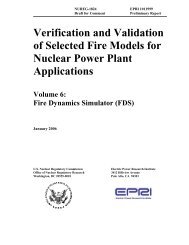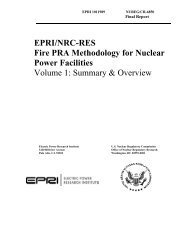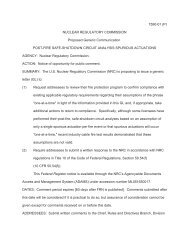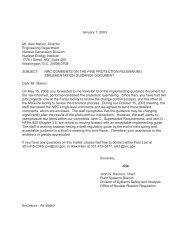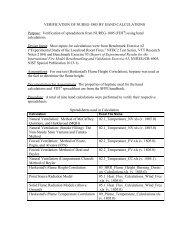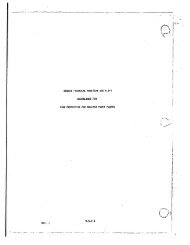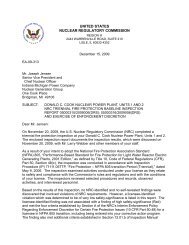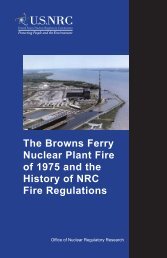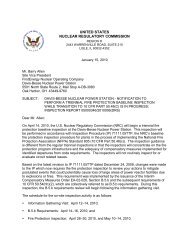Obstructed Sprinkler Piping - Hughes Associates, Inc.
Obstructed Sprinkler Piping - Hughes Associates, Inc.
Obstructed Sprinkler Piping - Hughes Associates, Inc.
Create successful ePaper yourself
Turn your PDF publications into a flip-book with our unique Google optimized e-Paper software.
1<br />
<strong>Obstructed</strong> <strong>Sprinkler</strong> <strong>Piping</strong><br />
A Ticking Time Bomb<br />
Bruce Campbell<br />
Director, Denver Office
2<br />
Purpose<br />
Description of the<br />
Problem<br />
Obstruction Sources<br />
Investigation<br />
Procedures<br />
Flushing Procedures<br />
Obstruction<br />
Prevention<br />
Outline<br />
Specific Code<br />
References<br />
Real World Example<br />
Conclusions<br />
Acknowledgements<br />
References
3<br />
Purpose<br />
Provide information on the importance of<br />
obstruction investigations to the operability<br />
of automatic sprinkler systems<br />
Provide a real world example of the failure<br />
of a sprinkler system due to obstructed<br />
sprinkler piping, and the resulting large loss<br />
fire
4<br />
Description of the Problem<br />
For sprinklers to be effective, there must be an<br />
unobstructed flow of water<br />
Clearly sprinklers are very effective, BUT, there have been<br />
numerous instances of impaired sprinkler efficiency<br />
because the sprinkler piping or sprinklers were plugged<br />
(NFPA 25, Appendix D), with<br />
o pipe scale o stones o Mud<br />
o corrosion products o other foreign material<br />
When sprinklers open, the obstructive material is broken<br />
loose, carried along the pipe, then plugging some of the<br />
sprinklers or forming obstructions at the fittings
5<br />
Common Sources<br />
of Obstruction
6<br />
Pipe Scale<br />
Involved in the majority of the<br />
obstructed sprinkler fire losses<br />
Dry pipe systems that have been<br />
maintained wet and then dry<br />
alternately over a period of years<br />
are particularly susceptible<br />
Dry pipe systems that are<br />
continuously dry are also<br />
vulnerable due to condensate in the<br />
air, which generally occurs at the<br />
bottom of the pipe<br />
Photos courtesy of Jeffery Moore, <strong>Hughes</strong> <strong>Associates</strong>, <strong>Inc</strong>.
Common Sources of Obstruction<br />
7<br />
Wood<br />
Careless Installation<br />
Paint brushes<br />
Buckets<br />
Gravel<br />
Sand<br />
Gloves<br />
or Repair<br />
Cutout discs/coupons<br />
Photos courtesy of<br />
Jeffery Moore,<br />
<strong>Hughes</strong> <strong>Associates</strong>, <strong>Inc</strong>.
Common Sources of Obstruction<br />
8<br />
Raw Water Sources<br />
Material sucked up from the bottom of<br />
rivers, ponds or open reservoirs by fire<br />
pumps with poorly arranged or inadequately<br />
screened or maintained intakes<br />
o Rust<br />
o Mud<br />
o Stones<br />
o Cinders<br />
Photo courtesy of Jeffery Moore, <strong>Hughes</strong> <strong>Associates</strong>, <strong>Inc</strong>.
Common Sources of Obstruction<br />
9<br />
Biological Growth<br />
Asiatic clam (raw river or lake water)<br />
o Grow 9 mm to 11 mm in 1 year and up to 54 mm<br />
in 6 years<br />
o Enter sprinkler piping in the larval stage or while<br />
still small, then feed on the bacteria or algae<br />
o Brought to the United States (Washington State)<br />
from Asia in the 1930’s, now throughout at least<br />
33 states<br />
o Highly infested areas include the Ohio River,<br />
Tennessee River Valley, Savannah River,<br />
Altamaha River, Columbia River, and Delta-<br />
Mendota Canal<br />
Photo courtesy of Jeffery Moore,<br />
<strong>Hughes</strong> <strong>Associates</strong>, <strong>Inc</strong>.
Common Sources of Obstruction<br />
10<br />
Calcium Carbonate<br />
Deposits<br />
Natural fresh waters contain<br />
dissolved calcium and magnesium<br />
salts<br />
If the concentrations are high the<br />
water is considered “hard”<br />
The ability of CsCO 3 to precipitate<br />
on the metal pipe surface depends<br />
on the water’s total acidity or<br />
alkalinity, and the concentration of<br />
dissolved solids in the water
Common Sources of Obstruction<br />
11<br />
Calcium Carbonate<br />
Deposits<br />
In sprinkler systems the calcium<br />
carbonate scale tends to occur on the<br />
more noble metals (copper)<br />
Consequently scale formation<br />
naturally forms on sprinklers, often<br />
plugging the orifice<br />
This type of obstruction cannot be<br />
detected or corrected by normal<br />
flushing and can only be found by<br />
inspection/replacement of the<br />
sprinklers in suspected areas<br />
Courtesy of Jeffery Moore,<br />
<strong>Hughes</strong> <strong>Associates</strong>, <strong>Inc</strong>.
Common Sources of Obstruction<br />
12<br />
Calcium Carbonate<br />
Deposits<br />
Most public utilities in very hard<br />
water areas soften their water, thus<br />
the most likely locations for<br />
deposits are where sprinklers are<br />
not connected to the public utility<br />
(wells, etc).<br />
Hard water areas include the<br />
Mississippi basin west of the<br />
Mississippi River and North of the<br />
Ohio River, the rivers of Texas<br />
and the Colorado basin.
Common Sources of Obstruction<br />
13<br />
Map of Hard Water Areas<br />
Courtesy of NFPA 25, Appendix D, Figure D.2.5(a)
Common Sources of Obstruction<br />
14<br />
Calcium Carbonate<br />
Deposits<br />
Areas most likely to have deposits are<br />
o In wet pipe sprinkler systems only<br />
o In high temperature areas (near dryers, ovens<br />
skylights), except where water has unusually<br />
high pH.<br />
o Old sprinkler systems that are frequently<br />
drained and refilled<br />
o In pendent sprinklers that are located away<br />
from air pockets and near convection currents
Common Sources of Obstruction<br />
15<br />
Microbiologically Influenced<br />
Corrosion (MIC)<br />
Most common biological<br />
growths are formed by<br />
microorganisms, including<br />
bacteria and fungi<br />
These microbes produce<br />
colonies (biofilm, slimes)<br />
containing a variety of<br />
microbobes<br />
These colonies form on the<br />
surface of wetted pipe in<br />
both wet and dry systems<br />
and deposit iron, manganese<br />
and various salts onto the<br />
pipe surface<br />
Photo courtesy of Jeffery Moore,<br />
<strong>Hughes</strong> <strong>Associates</strong>, <strong>Inc</strong>.
Common Sources of Obstruction<br />
16<br />
Microbiologically Influenced<br />
These discreted deposits*<br />
cause obstruction to water<br />
flow and can also dislodge<br />
causing plugging of fire<br />
sprinkler components<br />
Subsequent under-deposit<br />
pitting can also result in<br />
pinhole leaks<br />
* termed nodules, tubercles<br />
and carbuncles<br />
Corrosion (MIC)<br />
Photo courtesy of Jeffery Moore, <strong>Hughes</strong> <strong>Associates</strong>, <strong>Inc</strong>.
Common Sources of Obstruction<br />
17<br />
Microbiologically Influenced<br />
Corrosion (MIC)<br />
MIC is corrosion influenced by the presence<br />
of and the activities of microorganisms<br />
It almost always occurs with other forms of<br />
corrosion<br />
MIC is most often seen as severe pitting
Common Sources of Obstruction<br />
18<br />
Microbiologically Influenced<br />
Corrosion (MIC)<br />
MIC is first noticed as a result of<br />
pinhole leaks after only months to<br />
a few years of service<br />
Initial tests for the presence of<br />
MIC should involve on-site<br />
testing for microbes and chemical<br />
species (iron, pH and oxygen)<br />
Samples are easily taken from the<br />
inspectors test connection and/or<br />
main drain<br />
Courtesy of American Fire<br />
<strong>Sprinkler</strong> Association
Common Sources of Obstruction<br />
19<br />
Microbiologically Influenced<br />
Corrosion (MIC), continued<br />
The occurrence and severity of MIC is<br />
enhanced by<br />
o Using untreated water<br />
o Introduction of new and untreated water<br />
containing oxygen, microbes, salts and<br />
nutrients<br />
o Leaving dirt, debris, pipe joint compound, and<br />
especially oils in the piping, which all provide<br />
nutrients for microbiological growth
20<br />
Obstruction Investigation<br />
Per NFPA 25, Section 13.2.1 “An<br />
investigation of piping and branch line<br />
conditions shall be conducted every five<br />
years by opening a flushing connection at<br />
the end of one main and by removing a<br />
sprinkler toward the end of one branch line<br />
for the purpose of investigating for the<br />
presence of foreign organic and inorganic<br />
material”
21<br />
Obstruction Investigation<br />
Per NFPA 25, Section 13.2.1.1, Alternative<br />
nondestructive examination methods are<br />
permitted<br />
o Ultrasonic<br />
o X-ray<br />
Per NFPA 25, Section 13.2.1.2, Nodules or<br />
slime, if found shall be tested for MIC.
22<br />
Additional Criteria to Perform<br />
an Obstruction Investigation<br />
Defective intake for fire<br />
pumps taking suction from<br />
open bodies of water<br />
Discharge of materials<br />
during routine testing<br />
Foreign materials in<br />
pumps, valves, etc.<br />
Foreign material in water<br />
during drain tests or<br />
plugging of inspectors test<br />
connection<br />
Plugging of sprinklers<br />
Plugged sprinkler piping<br />
found during renovations<br />
Failure to flush yard<br />
piping after new<br />
installations or repairs<br />
Broken public mains in<br />
the vicinity<br />
Reduced flows during<br />
routine underground<br />
testing (loop tests)
23<br />
Additional Criteria to Perform<br />
an Obstruction Investigation<br />
Abnormally frequent false<br />
tripping of dry pipe valves<br />
A system that is returned<br />
to service after more than<br />
1 year of isolation<br />
A reason to believe that<br />
the system contains<br />
sodium silicate<br />
Pinhole leaks<br />
A system that at some<br />
point was supplied by raw<br />
water via the fire<br />
department connection<br />
A 50% increase in the<br />
time it takes water to<br />
travel to the ITC during<br />
full flow DPV trip tests<br />
when compared to the<br />
acceptance tests
24<br />
Investigation Procedures
Investigation Procedures<br />
25<br />
Investigate Yard Mains First<br />
Flow through yard<br />
hydrants, preferably<br />
near the extremes<br />
Use burlap bags to<br />
catch debris<br />
If obstructive material<br />
is found, all mains<br />
should be flushed<br />
Photo above courtesy of Joseph G. Pollard Company
Investigation Procedures<br />
26<br />
Investigating <strong>Sprinkler</strong> Systems<br />
Investigate dry systems first, representative<br />
systems are usually sufficient<br />
If obstructive material is found, investigate all of<br />
the systems<br />
System can be considered ok if<br />
o Less than ½ cup of scale is washed from the cross<br />
mains<br />
o Scale fragments are not large enough to plug a sprinkler<br />
orifice<br />
o A full, unobstructed flow is obtained from each<br />
branchline
Investigation Procedures<br />
27<br />
Investigating <strong>Sprinkler</strong> Systems<br />
When selecting systems or branch lines for<br />
investigation, consider lines found obstructed<br />
during a fire (in reality this must be done<br />
immediately after discovery) and/or systems<br />
adjacent to points of recent repair to yard mains<br />
Tests should include flows through a 2 ½ inch fire<br />
hose directly from cross mains and flows through<br />
1 ½ inch fire hose for branch lines<br />
Two or three branch lines is considered<br />
representative for each sprinkler system
Investigation Procedures<br />
Investigating <strong>Sprinkler</strong> Systems<br />
Fire pumps should be used to ensure<br />
sufficiently large flows<br />
Burlap bags should be used to collect<br />
dislodged material<br />
Each flow should be continued until the<br />
water clears (absolute minimum of 2 of 3<br />
minutes)<br />
Courtesy of Flo-Pak, <strong>Inc</strong>
Investigation Procedures<br />
29
Investigation Procedures<br />
30<br />
Flushing Of Branchline with<br />
1½ Fire Hose and Burlap Bag
Investigation Procedures<br />
31<br />
Debris from Flushing<br />
*greater than 1/2 cup<br />
Investigation*
Investigation Procedures<br />
32<br />
<strong>Sprinkler</strong> Systems<br />
Dry pipe systems should be flooded (made wet)<br />
one or two days prior to the examination (make<br />
sure to initiate compensatory measures due to the<br />
isolation of the sprinkler flow alarm)<br />
Restore the system and then trip the system as a<br />
simulation of normal action and flow the water<br />
through the 1 ½ inch hose lines into a burlap bag<br />
After the branch lines are examined and cleared,<br />
test the cross mains by discharging water through<br />
a 2 ½ inch fire hose and collect material in a<br />
burlap bag
Investigation Procedures<br />
33<br />
Replacement of elbow at end of<br />
cross main with flushing<br />
connection consisting of a<br />
2 inch nipple and cap<br />
Courtesy of NFPA 25, Appendix D, Figure D.3.2(a)<br />
Connection of 2½ inch<br />
hose gate valve with 2<br />
inch bushing and<br />
elbow to 2 inch cross<br />
main<br />
Courtesy of NFPA 25, Appendix D, Figure D.3.2(b)
34<br />
Flushing Procedures
Flushing Procedures<br />
35<br />
Yard Mains<br />
Yard mains should be thoroughly flushed<br />
before interior piping<br />
Flush at dead ends of the system or through<br />
blow-off valves<br />
Run water until clear (at least 2 to 5<br />
minutes)<br />
If looped system, close divisional valves to<br />
produce a higher velocity flow through each<br />
single line
Flushing Procedures<br />
36<br />
Yard Mains<br />
A velocity of at least 10 ft/sec is<br />
necessary to flush foreign material (see<br />
Table D.5.1 of NFPA 25 for the flow rate<br />
per pipe size to accomplish this velocity)<br />
Connections from the yard mains to<br />
sprinkler risers also need flushing (easy<br />
to forget)<br />
o 2 inch drain generally not sufficient<br />
o Can use FDC with clappers removed
Flushing Procedures<br />
37<br />
Flushing of Lead-in<br />
Courtesy of NFPA 25, Appendix D, Figure D.5.1
Flushing Procedures<br />
38<br />
Two methods<br />
<strong>Sprinkler</strong> <strong>Piping</strong><br />
o Hydraulic method<br />
o Hydropneumatic method<br />
Hydraulic Method<br />
o Flowing water from the yard mains sprinkler<br />
riser feed mains cross mains branch<br />
lines in the same direction as in a fire
Flushing Procedures<br />
39<br />
<strong>Sprinkler</strong> <strong>Piping</strong><br />
Hydropneumatic method<br />
o Using special equipment and compressed air to blow a<br />
charge of about 30 gallons of water from the ends of the<br />
branch lines back to the feed mains and down the riser,<br />
washing material out of an opening at the base of the<br />
riser<br />
Sufficient velocity is required for both methods<br />
Pendent sprinklers should be removed and<br />
inspected at random locations until it is reasonably<br />
assured that they are free of obstructions
Flushing Procedures<br />
40<br />
<strong>Sprinkler</strong> <strong>Piping</strong><br />
Choice of method depends on conditions<br />
o If examination indicates the presence of loose<br />
sand, mud or moderate pipe scale the hydraulic<br />
method is generally effective<br />
o Where the material is more difficult to remove<br />
and available water pressures are too low, the<br />
hydropneumatic method is preferred<br />
o The hydropneumatic should not be used with<br />
CPVC piping
41<br />
Hydropneumatic Machine<br />
Courtesy of NFPA 25, Appendix D, Figure D.5.4(a)
42<br />
Obstruction Prevention
Obstruction Prevention<br />
43<br />
Dry Pipe<br />
and Preaction Systems<br />
Those using noncoated ferrous piping should be<br />
investigated for obstruction from corrosion after<br />
15 years, 25 years and every 5 years there after (in<br />
addition to flushing investigations)<br />
Those using noncoated ferrous piping should be<br />
left on air the year around<br />
Internally galvanized piping should be used for<br />
new systems. Fitting and couplings are not<br />
required to be galvanized.
Obstruction Prevention<br />
44<br />
Other Solutions<br />
to Mitigate the Problem<br />
“The New<br />
Galvanized Pipe”<br />
ASTM A653 zinc<br />
adhesion test<br />
Contact<br />
Curt Brown<br />
(815) 465-2102<br />
Courtesy of IDOD Systems, <strong>Inc</strong>.
Obstruction Prevention<br />
45<br />
Flushing Connections<br />
NFPA 13 requires a flushing connection at each<br />
cross main (Section 8.14.16)<br />
Branch lines on gridded systems should be<br />
capable of being readily broken at a simple union<br />
or flexible joint<br />
NFPA 13 (Section 8.14.18) also requires the use<br />
of return bends to reduce the chances of debris<br />
dropping into the drop nipples. These are not<br />
required for deluge systems or dry pendant heads.
46<br />
Return Bend<br />
Courtesy of NFPA 13, Figure 8.14.18.2<br />
Flushing Connections for<br />
Branchlines<br />
All courtesy of Jeffery Moore,<br />
<strong>Hughes</strong> <strong>Associates</strong>, <strong>Inc</strong>.
Obstruction Prevention<br />
47<br />
Obstruction Prevention<br />
Screen pump suction supplies must be properly<br />
maintained (screen size criteria in NFPA 20)<br />
Asian Clams<br />
o To date, no effective method of total control has been<br />
found<br />
Calcium Carbonate<br />
o In hard water areas; a representative sample of<br />
sprinklers should be removed and inspected yearly<br />
o If deposits are found, replace those and adjacent<br />
sprinklers
Obstruction Prevention<br />
48<br />
Zebra Mussels<br />
Molluscides are effective, but very expensive<br />
Chlorination is best for short term treatment<br />
o There are strict EPA regulations<br />
o Could be devastating to the entire ecosystem<br />
Control measures should be applied at the water<br />
source, not within the piping system<br />
o Select a water source that is not subject to infestation<br />
o Implement water treatment including biocides, elevated<br />
pH<br />
o Implement water treatment that reduces O 2
49<br />
Specific Code References<br />
Subject NFPA 25 Reference<br />
Obstruction Investigation<br />
(requirement)<br />
Chapter 13<br />
Obstruction Investigation<br />
(informational)<br />
Annex D.1<br />
Obstruction Sources Annex D.2<br />
Investigation Procedures Annex D.3<br />
Obstruction Prevention Program Annex D.4<br />
Flushing Procedures Annex D.5
50<br />
Real World Example<br />
Mill plant in Lowell, MA<br />
Masonry, Plank on Timber construction,<br />
multi-story, single occupancy<br />
Fire protection water (suction source) was<br />
from a cannel near the facility<br />
Small fire and the initial sprinkler did not<br />
operate (fused but did not flow)<br />
The fire progressed with few or no<br />
sprinklers operating
51<br />
Real World Example<br />
Fire Department affected final<br />
extinguishment<br />
Total loss well over $10M<br />
During post fire investigation, sprinkler<br />
piping was closely investigated and most<br />
if not all of the sprinkler piping was<br />
obstructed with a fibrous algae type of<br />
material
52<br />
Real World Example<br />
Interviews<br />
revealed that the<br />
facility had not<br />
conducted<br />
flushing<br />
examinations
53<br />
Real World Example<br />
During the investigation even the 2 1/2 inch cross<br />
mains were obstructed; thus a simple examination<br />
of the interior of the pipe would have revealed the<br />
extent of the obstruction<br />
Both courtesy of Tommy Brown
54<br />
Conclusions<br />
Obstruction Investigations are clearly<br />
required by NFPA 25 (Chapter 13),<br />
It’s not obvious that this is being<br />
accomplished on a frequent basis<br />
NFPA 25 provides clear criteria for flushing<br />
investigations and the flushing of systems<br />
(if warranted)<br />
Don’t let your in-place bright and shinny<br />
sprinkler system lull you into false security
55<br />
Conclusions<br />
Establish a program now to<br />
perform the investigations<br />
o Owners: Do it!<br />
o AHJ: Enforce it!<br />
o Consultants: Ask the right<br />
questions, provide the right<br />
advise<br />
o Vendors: Push this important<br />
ITM function<br />
Don’t become a<br />
Sitting Duck!<br />
Courtesy of Michael Bedard
56<br />
Acknowledgements<br />
Ed Budnick, P.E.,Vice President<br />
<strong>Hughes</strong> <strong>Associates</strong>, <strong>Inc</strong>.<br />
David Tomecek, P.E., Senior Engineer<br />
<strong>Hughes</strong> <strong>Associates</strong>, <strong>Inc</strong>.<br />
Jeff Moore, P.E., Senior Engineer<br />
<strong>Hughes</strong> <strong>Associates</strong>, <strong>Inc</strong>.<br />
Dean K. Wilson, P.E.<br />
<strong>Hughes</strong> <strong>Associates</strong>, <strong>Inc</strong>. (retired)
57<br />
References<br />
NFPA 13, “Standard for the Installation of<br />
<strong>Sprinkler</strong> Systems”, 2002 Edition<br />
NFPA 25, “Inspection, Testing, and Maintenance<br />
of Water-Based Fire Protection Systems”, 2002<br />
Edition<br />
FPC/Fire Protection Contractor, November 2003;<br />
“Is it “MIC”, Richard O’Leary<br />
FPC/Fire Protection Contractor, November 2003;<br />
“The New Galvanized Pipe”, Curt Brown





